- About Us
- Columns
- Letters
- Cartoons
- The Udder Limits
- Archives
- Ezy Reading Archive
- 2024 Cud Archives
- 2023 Cud Archives
- 2022 Cud Archives
- 2021 Cud Archives
- 2020 Cud Archives
- 2015-2019
- 2010-2014
- 2004-2009
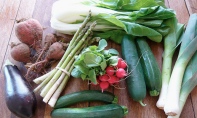 |
July 2010 - What's All The Fuss With Food? |
I’m ashamed to admit that I had a rather slow start on learning the horrors of America’s industrialized food industry. I arrived in the United States, the land of plenty, believing that all the hype over obesity and its related diseases were simply due to poor choice and an over zealous fast-food industry. It took a move from a great metropolis to the wilds of New Mexico to reveal the realities of America’s industrialised food.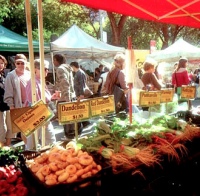
Prior to moving South, I spent two years enjoying the fruits of the Big Apple. It’s true that it never sleeps, how could it when it’s facilitating more than 20,000 restaurants that are servicing some of the pickiest palates in the world. My place of work was nicely nestled in Union Square with its famed Farmer’s Market. I was able to peruse the various stalls to satisfy my hunger and on non-market days the Whole Foods Market opposite supplied me with my next meal. Dinner was mostly had at one of the 20,000 restaurants, which substituted for my lack of kitchen and dining space. I did reflect on the prices I was paying but these were never bulk purchases and the food was generally organic which as far as I knew was worth the premium.
One of the deciding factors to move to the mountains of New Mexico was a change in pace not to mention space. I relocated to East Mountains, some 15 miles from the high desert town of Albuquerque. Of course with every change there are always adjustments. The local artisan stores that I’d relied on so heavily for my basics were now replaced by supermarkets, their sheer size giving infinity some perspective. It was time for me to shop in bulk, fill the pantry and return to the kitchen. I was going to become my own gourmet chef! And how could I not with these astounding prices -meat especially was oh-so cheap- the food was almost free.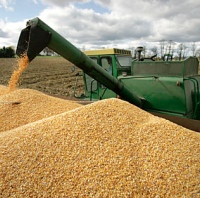
Ah, but nothing comes for free. By ignorantly eating ridiculously cheap food, I managed to contract an antibiotic resistant bug that most likely was the result of indulging in feedlot meat. Ignorance is bliss until your intestines don’t work. I could no longer continue my food neophyte ways and trust that the food industry had my health priorities above its bottom line.
I began an intensive inquiry by viewing alarming documentaries including Food Inc. and Corn King. This almost completely destroyed any enjoyment I once had from food to the point where I felt that almost anything I put in my mouth would harm me. While this had an incredible impact in the short term, hunger and cravings soon won out. The simple solution to my dilemma was no meat and a return to Whole Foods. I would rely on this super market’s reputation of social responsibility and natural foods to supply me with nutritionally packed and sustainable ingredients - solved. However, as anyone will attest, Whole Foods is not economical foods. These bulk-shopping trips with the additional 40 miles worth of gas were fiscally alarming and no solution for me.
I needed to establish a real understanding of organic and local foods.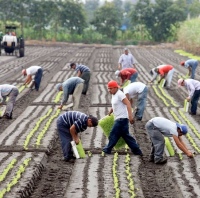 I really liked the idea of local food, it’s carbon friendly and it makes sense. I wasn’t entirely convinced by the purely organic argument, especially when one can pick-up a box of organic Kraft Mac & Cheese – surely that is marketing beyond the realms of truth. The organic example that puzzled me most was the oranges sourced from Australia at my local supermarket. Wouldn’t the jet-fuelled trip halfway across the globe negate any benefits of growing organically? Surely that Florida orange with its shorter journey and its light dusting of pesticide is better tasting and perhaps just a little more eco friendly? There was also my acre of land to consider, perhaps I could test the colour of my thumbs and create an organic vegetable oasis.
I really liked the idea of local food, it’s carbon friendly and it makes sense. I wasn’t entirely convinced by the purely organic argument, especially when one can pick-up a box of organic Kraft Mac & Cheese – surely that is marketing beyond the realms of truth. The organic example that puzzled me most was the oranges sourced from Australia at my local supermarket. Wouldn’t the jet-fuelled trip halfway across the globe negate any benefits of growing organically? Surely that Florida orange with its shorter journey and its light dusting of pesticide is better tasting and perhaps just a little more eco friendly? There was also my acre of land to consider, perhaps I could test the colour of my thumbs and create an organic vegetable oasis.
I looked to the food purists for guidance, beginning with Gary Paul Nabhan’s Coming Home to Eat. It seemed the perfect starter guide to local food in the Southwest. Nabhan’s yearlong trial to eat foods from within a 220 mile radius of his Arizona home was beautiful and fascinating but to me, completely daunting. This man has a PhD in regional foods where I had a photographic memory of aisled foods. I wasn’t acquainted with my neighbours yet, let alone where to source indigenous seeds, and the fact that the only constructive gardening I had practised up to that point was a de-weeding application of Roundup, clearly meant I wasn’t ready for this kind of transition. However, my newfound knowledge of the food system left me desperately wanting to join my new community in support of sustainable food and its producers. 
Winter was coming to an end but it was still going to be a few months before I could join my community in sampling local fare from the seasonal farmer’s markets, not to mention get some gardening 101 under my belt. I had discovered the catharsis in cooking. The experience had transformed me in more ways than one. Since I was putting all this love, care and effort into my meals I wanted to know where my food came from, I wanted to meet the people like Nabhan had. It was there on the New Mexico Farmer’s Market website that I discovered Community Supported Agriculture (CSA).
I’d read about these CSA’s, in fact, Nabhan had mentioned them. For some reason, I viewed them as a subculture of the food elite, a gang that required you to know far more about horticulture than I obviously did. What would they do if I received a box full of veg I couldn’t identify, would they shun me for my ignorance – I had already suffered food shame. But this could be my link to the elusive community. The wait for the markets was still months away so I decided to take the plunge and commit our household to a weekly box of sustainable, locally grown veg for the grand total of $26.00 a week. To add to this trial, I could collect my box at a designated location not far from home. What a deal, especially when looking at the last Whole Foods bill.
I was pleasantly surprised with my box, nothing too outrageous, potatoes, kale, Swiss chard, broccoli, apples, sweet potatoes, and a newsletter from the farmer that included recipe suggestions for that week's contents, plus an update on the farms progress and what yields to expect from the coming months. I’m not exaggerating when I say that the first week of meals tasted better than anything I had ever prepared before. 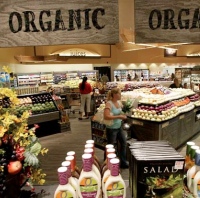 However, I noted a few items that hadn’t come from my farm (I was a shareholder now so I can say my) made obvious by the stickers that heralded them from California. This raised a brow. After contacting the farm to enquire, I was given a quick lesson on high desert farming and its limitations. This is where the difference between local and organic became apparent.
However, I noted a few items that hadn’t come from my farm (I was a shareholder now so I can say my) made obvious by the stickers that heralded them from California. This raised a brow. After contacting the farm to enquire, I was given a quick lesson on high desert farming and its limitations. This is where the difference between local and organic became apparent.
Like several other CSA’s, Los Poblanos went the extra mile in sourcing other sustainably organic grown goods to ensure that all the shareholders received a well-balanced, value for money box and, I’ll be honest, I like a bit of variety. The difference being that these foods were not sourced from large corporations just skirting the rules that make them organic but small producers who work as my farm does. No growing season is alike and some areas are easier than others so flexibility is required. To add to this they also sourced other local items including bread, cheese and milk that members could add to their weekly box. I was invited to come and have a look and for just 2.5hrs of my time they could put me to work and I would get 50% off the price of my box – sold.
This problem solving exercise turned out to be positive in more ways than I could have expected. 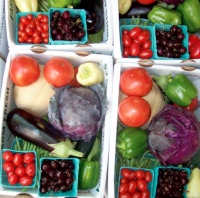 After getting my hands dirty on the farm I became part of a true community and I learnt a thing or two about planting (no more Roundup for this budding gardener). I remember reading the praise for restaurants in California and New York that had sourced food from local producers – farm to table. I, of course, was one of those who paid a premium to eat there. Now, here I was, harvesting the lettuce that would be the main feature in my salad that evening and, believe me, the financial cost of that lettuce was nothing compared to the pride I gained from picking it and knowing what I would create with it (not to mention the taste). I was also pleased to learn that most CSA’s accept food stamps so this really is a community concept.
After getting my hands dirty on the farm I became part of a true community and I learnt a thing or two about planting (no more Roundup for this budding gardener). I remember reading the praise for restaurants in California and New York that had sourced food from local producers – farm to table. I, of course, was one of those who paid a premium to eat there. Now, here I was, harvesting the lettuce that would be the main feature in my salad that evening and, believe me, the financial cost of that lettuce was nothing compared to the pride I gained from picking it and knowing what I would create with it (not to mention the taste). I was also pleased to learn that most CSA’s accept food stamps so this really is a community concept.
I had put my faith in an industrialized food system that had not only failed me but had also taken away the joy of what was once a respected and prioritized past-time, the shared experience of food preparation and consumption. This is not an elitist nor confusing realm my, friends, it was once part of our ancestors lives and I’m all for bringing it back. If we want our food system to change, we need to demand what we want and allow ourselves to be open to change. There are ways and means to suit us all whether it be community gardens, CSAs, Farmer’s Markets or Whole Foods Markets- it’s our choice to make. I am still learning new ways in sustainable living that happen to be saving my health, the environment and my bank balance.
For more writing by Kirsten Moore visit: http://eastmountaintales.blogspot.com/
